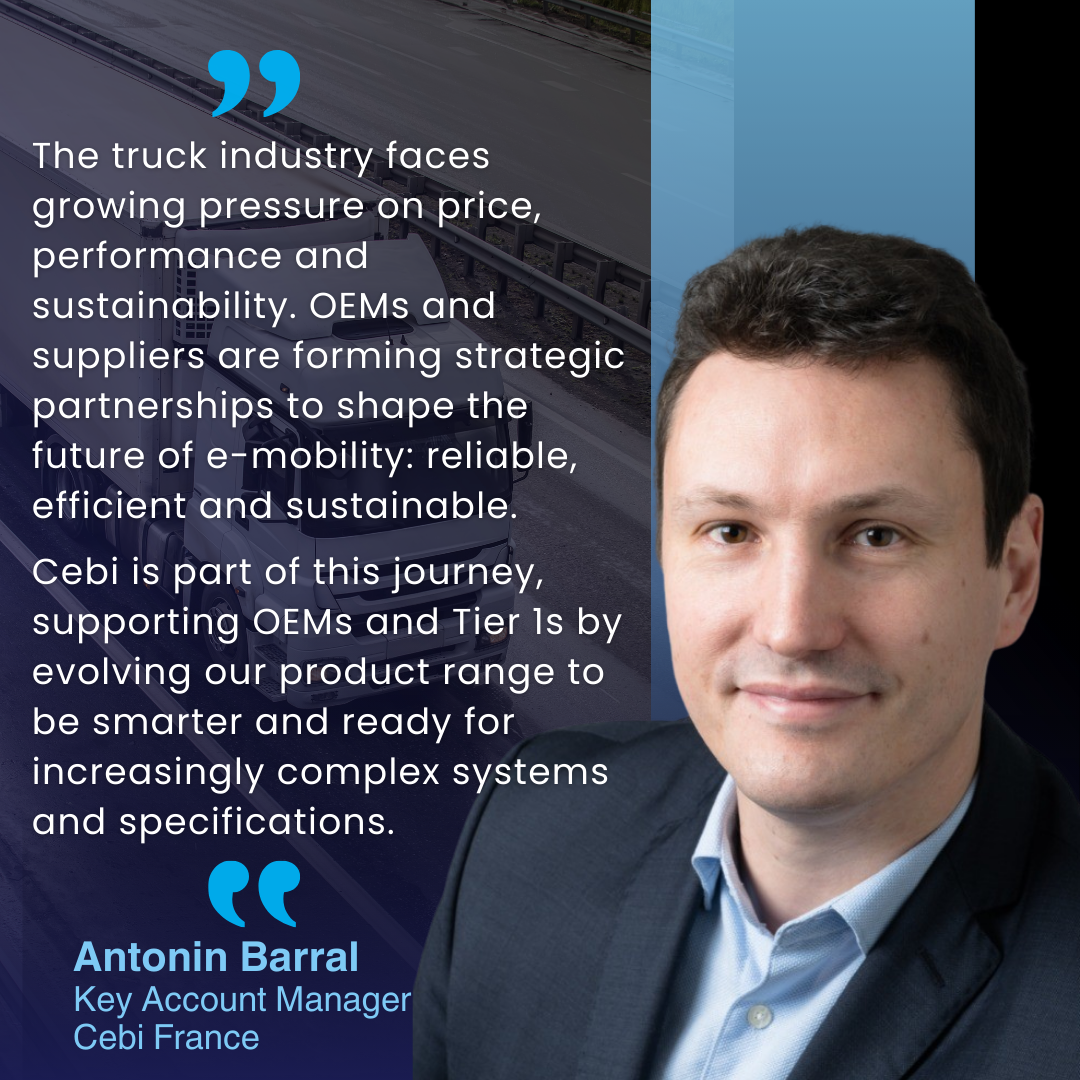Top trends in the Truck & Heavy-Duty Vehicle Landscape
Top trends in the Truck & Heavy-Duty Vehicle Landscape
Across Europe, the Americas, and Asia, Cebi is strengthening its position by supplying robust, high-value components that perform under the most demanding conditions.
A Market in Transformation
The heavy-duty market is driven by long vehicle lifecycles, high mileage, and strict reliability expectations. Despite lower yearly volumes than passenger cars, trucks use more components per vehicle, making every program strategically important.
Mergers, acquisitions, and joint ventures, such as Volvo with Daimler, Iveco with Tata, or UD Trucks with Isuzu, are also reshaping supply chains and creating new opportunities for suppliers with a flexible global footprint.
Electrification is now a major focus. OEMs are investing in battery-electric powertrains, e-axles, and hydrogen fuel-cell platforms, all of which require advanced sensing and thermal management.

5 top Key Market and Technical Trends
#1.Electrification and Hydrogen Technologies
Heavy-duty OEMs are rapidly expanding their investment in battery-electric trucks, multi-motor e-axles, hydrogen fuel-cell systems, and even H2 combustion engines. This transition pushes suppliers to deliver robust, high-voltage-compatible components able to withstand continuous operation.
OEMs worldwide are investing in:
- Battery-electric trucks, including multi-motor e-axles.
- Full-cell platforms (Daimler/Volvo joint venture Cellcentric).
- Hydrogen combustion engines, notably in Germany and Scandinavia.
Electric platforms require:
- High-precision oil level sensors
- Coolant management (valves, pumps, temperature sensors)
- Position and pressure sensors for thermal & safety systems
Cebi already equips electric axles with multiple oil-level and pressure sensors.
#2. Increased Component Multiplication
Many heavy-duty vehicles require several units of the same component per vehicle, for example:
- Up to 4 oil level sensors on Volvo’s electric trucks
- Several actuators and latches on each cabin
- Large washer systems with multiple pumps and nozzles
- Multiple latches for service flaps and cabin tilt
- Multiple temp sensors in H2FC and thermal management system (up to 8pcs)
This makes the business model extremely attractive for robust, high-value components.

#3. Growing influence of Tier-1
Tier-1 companies such as Hengst, Knorr-Bremse, MAN+Hummel, or Pierburg increasingly shape vehicle architecture.
For component manufacturers, collaboration with these system integrators is essential:
- They define technical specifications and develop off-the-shelf designs adaptable for multiple OEMs.
- They focus on system integration but need component support
- They open the door to global OEM platforms
Indirect supply through Tier-1s can secure access to programs that would otherwise be difficult to enter.
#4. China’s Rapid Technological Shift
China is accelerating its move from traditional heavy-duty technologies to electric and hydrogen platforms.
Key developments include:
- Increased adoption of EV powertrains
- New actuator concepts such as foldable camera or mirror actuators
- Cross-border partnerships with European OEMs
- A fast-growing domestic heavy-duty market looking for modernized systems
This dynamic environment favors suppliers capable of balancing cost, innovation, and global coordination.
#5. Expansion of the Defense Sector
Defense mobility programs across Europe and abroad are creating demand for components with:
- Enhanced robustness
- Long-term supply security
- Extreme-condition performance
- Special traceability and regulatory compliance
Customer Needs: Reliability, Global Support & Innovation
Heavy-duty OEMs demand components that offer:
- Maximum durability over long duty cycles: 24/7 operation, Vibration, shock, dust, mud, and chemicals, long life cycles (10+ years), 24V and 48V architectures
- Electrification-ready technologies for cooling, monitoring, and energy management: supporting hHigh-voltage systems and ensuring Fuel-cell safety (condensate management, conductivity sensors, PTC heaters)
- Safety and reliability, even in harsh environments
- Co-development capabilities across global R&D and purchasing teams
- Flexible supply models, either directly or via Tier-1 partners
They expect suppliers to deliver not only components but full engineering support, testing expertise, and the reassurance of long-term production stability.
How Cebi Supports These Industry Trends
Cebi’s portfolio and engineering capabilities align naturally with the evolution of the heavy-duty market:
✔ System Expertise, not Just Parts
Customers increasingly seek partners who can deliver:
- Complete washer systems
- Cabin latches & actuators
- Integrated sensing modules
- Support for co-engineering and rapid prototyping

✔ Innovation Aligned With Market Needs
Current developments include:
- Conductivity sensors for coolant safety
- PTC heaters for hydrogen systems
- Smart washer systems for large cabins
- Oil-level and pressure sensors for multi-motor electric axles
✔ A Comprehensive Portfolio for Heavy-Duty
Cebi provides many of the components most in demand today:
- Oil level and pressure sensors
- Temperature sensors for engines, e-axles, hydrogen systems
- Washer systems & pumps (including high-volume assemblies for MAN Brazil)
- Cabin latches, hood latches, tilt actuators
- Window lifter motors (Iveco)
- Fuel heaters & PTC heaters for extreme environments
- Modules, including new foldable camera actuators developed in Asia
✔ Expertise in Multi-Application Components
Our components operate across trucks, buses, construction machinery, agricultural machines, defense vehicles, and industrial engines, proving long-term robustness across environments.
This cross-sector experience strengthens our robustness and innovation.
✔ Global Engineering & Local Support
With R&D and testing centers across the world, Cebi supports OEMs through every development phase, ensuring fast response, adapted validation, and long-term production stability.
Cebi’s worldwide engineering centers ensure:
- Local customer support
- Adapted validation and testing
- Rapid prototype delivery
- Ability to support global programs and joint ventures
The truck and heavy-duty sector is entering a decisive new era. Electrification, hydrogen technologies and advanced system integration are reshaping vehicle architectures and redefining performance expectations. As global markets evolve and technologies accelerate, the industry will rely more than ever on partners who understand these shifts and can contribute to the next generation of heavy-duty mobility.